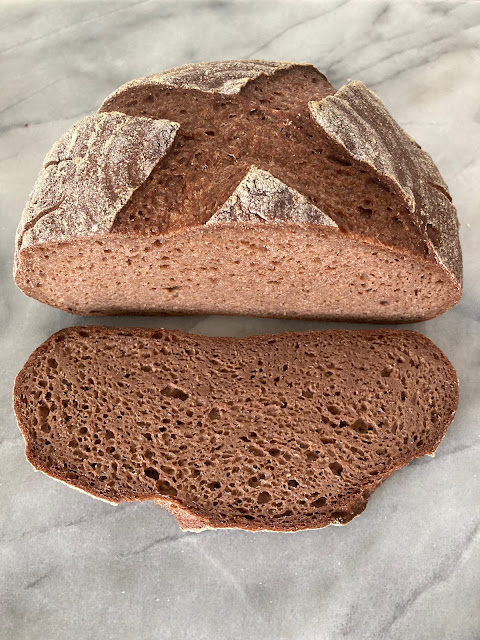Gluten-free Baguette Recipe from Gluten-free Artisan Bread in Five Minutes a Day
Photo credit: Stephen Scott Gross
|
I recently reviewed the new book Gluten-free Artisan Bread in Five Minutes a Day by Jeff Hertzberg and Zoe François. They have given me permission to share one of the recipes with you. It's one that I've tried several times and I've gotten to love making it on a regular basis.
If you don't have the book in hand yet, here's a recipe to get you started. It's reprinted with permission
from the Bread in 5 team. You can take a look at GFBreadin5.com for more information.
from the Bread in 5 team. You can take a look at GFBreadin5.com for more information.
Gluten-Free Baguette
Recipe adapted from Gluten-Free Artisan Bread in Five Minutes a Day and used with permission
Recipe adapted from Gluten-Free Artisan Bread in Five Minutes a Day and used with permission
©2014, Jeff Hertzberg and Zoë François
Makes eight ½-pound loaves. The recipe is easily doubled or halved.
This beautiful and crispy loaf is the symbol of France. Our gluten-free version is just as gorgeous and delicious. We brush the top of the loaf with egg white wash to create a glossy crust, but in a pinch, water will do.
Ingredients
6½ cups of gluten-free all-purpose flour (see GFBreadIn5.com/GFmix)
1 tablespoon granulated yeast
1-1½ tablespoons kosher salt [or 2 tsp. table salt- Gina]
2 tablespoons sugar or honey
3¾ cups lukewarm water (100°F or below) [I sometimes had to use more - Gina]
Cornmeal or parchment paper, for the pizza peel
Egg white wash (1 egg white plus 1 tablespoon water), for top of loaf
6½ cups of gluten-free all-purpose flour (see GFBreadIn5.com/GFmix)
1 tablespoon granulated yeast
1-1½ tablespoons kosher salt [or 2 tsp. table salt- Gina]
2 tablespoons sugar or honey
3¾ cups lukewarm water (100°F or below) [I sometimes had to use more - Gina]
Cornmeal or parchment paper, for the pizza peel
Egg white wash (1 egg white plus 1 tablespoon water), for top of loaf
· Mixing and storing the dough: Whisk together the flour, yeast, salt, and sweetener in a 5- to 6-quart bowl, or a lidded (not airtight) food container.
· Add the water and mix with a spoon or a heavy-duty stand mixer fitted with the paddle.
· Cover (not airtight), and rest at room temperature until the dough rises, about 2 hours.
· The dough can be used immediately after rising, though it’s easier to handle when cold. Refrigerate in a lidded (not airtight) container and use over the next 10 days. Or freeze for up to 4 weeks in 1-pound portions and thaw in the refrigerator overnight before use.
· On baking day: Dust the surface of the dough with rice flour, pull off a ½ -pound (orange-size) piece, and place it on a pizza peel prepared with cornmeal (use plenty) or parchment paper. Gently press and pat it into a log-shape with tapered ends, using wet fingers to smooth the surface. Allow to rest for about 40 minutes, loosely covered with plastic wrap or a roomy overturned bowl. During this time, the dough may not seem to rise much, which is normal.
· Preheat a baking stone near the middle of the oven to 450°F (20 to 30 minutes), with an empty metal broiler tray on any shelf that won’t interfere with rising bread.
· Brush the top with egg white wash, and then slash, about ½-inch deep, with a wet serrated bread knife.
· Slide the loaf onto the hot stone. Pour 1 cup of hot tap water into the broiler tray, and quickly close the oven door. Bake for about 35 minutes, or until richly browned and firm.
· Allow to cool completely on a rack before eating.
The authors answer questions at GFBreadin5.com, where you’ll also find recipes, photos, videos and instructional material.




Comments
Make 4 baguettes?
This recipe makes a bulk of dough and that you store in the fridge. The idea is that you can grab a different size ball of dough for whatever you want to make from the bulk ferment. So you could bake something different each day. The dough saves pretty well for, if I remember, about a week, probably more. So if you want two baguettes you grab two orange sized chunks of dough, then save the rest for your next bake. Thus the "5 minutes a day" concept. I hope that clears up the confusion!